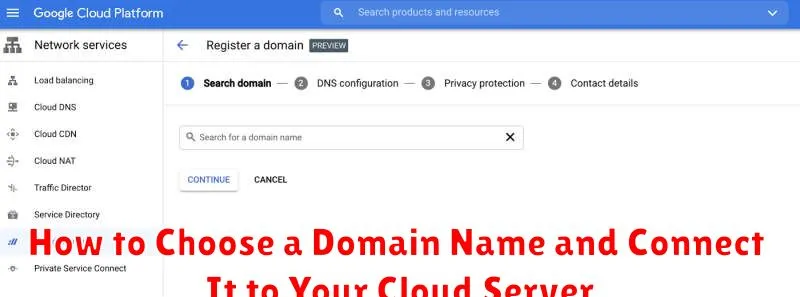Choosing the right domain name is a crucial first step in establishing your online presence. A well-chosen domain name is essential for branding, discoverability, and building credibility. This guide provides a comprehensive overview of how to select a domain name that effectively represents your business or personal brand and complements your online objectives. We will cover key factors to consider, such as domain extensions (like .com, .org, .net), keyword relevance, and brandability, helping you navigate the process of securing the perfect domain name for your website.
Once you’ve secured your ideal domain name, the next critical step is connecting it to your cloud server. This process allows your website content to become accessible at your chosen web address. This article outlines the process of connecting your domain name to various popular cloud server providers, simplifying the technical steps involved and providing clear instructions for seamless domain name server (DNS) configuration. Whether you’re using AWS, Google Cloud, Azure, or another provider, we’ll cover the essentials of pointing your domain name to your cloud server and making your website live.
Tips for Choosing the Right Domain
Selecting the right domain name is crucial for your online presence. A well-chosen domain can significantly impact your brand recognition and search engine rankings. Here are some key tips to consider:
Keep it short and memorable. Shorter domains are easier to remember and type, reducing the risk of typos and lost visitors. Aim for a domain that is easy to pronounce and spell.
Use relevant keywords. If possible, incorporate keywords related to your business or website content. This can improve your search engine optimization (SEO) and help potential customers find you more easily. However, avoid keyword stuffing, which can negatively impact your SEO.
Choose the right extension. The most common top-level domain (TLD) is .com, but other options like .org, .net, or industry-specific TLDs might be more suitable depending on your website’s purpose.
Check for availability. Before settling on a domain name, ensure it’s available. Use a domain registrar’s website to check availability and register your chosen domain promptly.
Consider your target audience. When choosing a domain, think about your target audience and their preferences. A domain name that resonates with your target demographic can significantly enhance your brand appeal.
Registering Through a Trusted Registrar
Once you’ve chosen your ideal domain name, the next step is registering it through a trusted registrar. A registrar is an organization accredited by the Internet Corporation for Assigned Names and Numbers (ICANN) to sell domain names. Choosing a reputable registrar is crucial for a smooth and secure registration process.
Research different registrars and compare their pricing, features, and customer support. Look for registrars that offer domain privacy, which protects your personal information from being publicly available in the WHOIS directory. Security features like two-factor authentication are also essential for protecting your account.
The registration process typically involves creating an account with the registrar, searching for the availability of your chosen domain name, and then completing the purchase. You’ll need to provide accurate contact information and payment details. After successful registration, you’ll receive confirmation and gain control over your domain’s settings.
Setting Up DNS Records Correctly
After registering your domain name, the next crucial step is configuring its DNS records to point to your cloud server. This process essentially tells the internet where to find your website or application.
The most important DNS records are the A record and the CNAME record. An A record maps your domain name directly to the IP address of your cloud server. This is essential for directing web traffic to the correct location.
A CNAME record, or Canonical Name record, maps your domain or subdomain to another domain name, often a hostname provided by your cloud provider. This is commonly used for services like www, mapping www.yourdomain.com to yourdomain.com.
You’ll manage these records through your domain registrar’s control panel. The specific steps vary depending on the registrar, but generally involve finding the DNS management section and adding or modifying records. You’ll need to specify the record type (A or CNAME), the hostname (e.g., @ for the root domain or www for the www subdomain), and the value (your server’s IP address for A records, or the target hostname for CNAME records).
Accurate configuration is vital. Incorrect DNS records can lead to your website being inaccessible. Double-check all entries before saving changes. DNS propagation can take time, from a few minutes to several hours, so be patient.
Connecting Domain to Your Cloud Server

After choosing and registering your domain name, the next crucial step is connecting it to your cloud server. This process directs web traffic to your server, making your website accessible via your chosen domain. This typically involves configuring your domain’s DNS records.
DNS (Domain Name System) records act like a directory, translating your domain name (e.g., example.com) into the IP address of your cloud server. Two essential records are A records and CNAME records.
An A record maps your domain or subdomain directly to the server’s IP address. For your root domain (example.com), you’ll point it to your server’s main IP address. You’ll need access to your domain registrar’s control panel to manage these records.
A CNAME record, or Canonical Name record, points a subdomain (e.g., www.example.com) to your root domain (example.com) or another hostname. It’s generally recommended to use a CNAME for the www subdomain, pointing it to your root domain’s A record.
Once you’ve updated your DNS records, it may take some time for the changes to propagate across the internet. This period, often referred to as DNS propagation, can typically range from a few minutes to up to 48 hours.
SSL and HTTPS Integration
Securing your website with SSL (Secure Sockets Layer) and HTTPS (Hyper Text Transfer Protocol Secure) is crucial for protecting user data and building trust.
SSL certificates encrypt the communication between a user’s browser and your server, preventing data interception. This encryption is indicated by the padlock icon in the browser’s address bar and the “https://” prefix in the URL.
There are various types of SSL certificates, including Domain Validated (DV), Organization Validated (OV), and Extended Validation (EV) certificates. DV certificates are the most basic and verify domain ownership. OV certificates offer a higher level of validation by verifying business details. EV certificates provide the highest level of assurance, displaying the organization’s name in the address bar.
After acquiring an SSL certificate, you’ll need to install it on your cloud server. The installation process varies depending on your server software (e.g., Apache, Nginx). Typically, you’ll upload the certificate files to your server and configure your web server software to use them.
Once installed, ensure your website redirects all HTTP traffic to HTTPS. This can be done through server configuration or by using plugins if your website uses a content management system.
Using Subdomains Effectively
Subdomains offer a powerful way to organize and structure your website content. They are extensions of your main domain name, appearing before it, separated by a dot. For instance, if your main domain is example.com, a subdomain could be blog.example.com or shop.example.com. Using subdomains strategically can significantly improve your site’s organization, user experience, and even SEO.
One of the key benefits of using subdomains is the ability to create distinct sections for different parts of your website. This is particularly useful for large websites or businesses with multiple product lines or services. By separating content into subdomains, you can provide a more focused user experience tailored to specific audiences. For example, a university might use students.university.edu for student resources and faculty.university.edu for faculty-related information.
Subdomains can also be beneficial from a technical perspective. They allow you to separate different parts of your website onto different servers or server configurations, which can improve performance and scalability. This is particularly advantageous for resource-intensive applications or sections of your website that receive a high volume of traffic.
Furthermore, using subdomains can help with search engine optimization (SEO). By creating targeted subdomains for specific keywords or topics, you can signal to search engines the relevance of that content, potentially improving your rankings for those terms.
Troubleshooting DNS Issues
DNS problems can prevent your domain name from connecting to your cloud server. Here’s a breakdown of common issues and how to resolve them.
Check Your DNS Records: Ensure the A record (for IPv4) or AAAA record (for IPv6) points to the correct IP address of your cloud server. An incorrect IP address will direct traffic to the wrong location. Similarly, verify the CNAME record for any subdomains (e.g., www) is correctly configured to point to your primary domain.
DNS Propagation Time: After updating DNS records, it takes time for these changes to propagate across the internet. This period, often called DNS propagation, can range from a few minutes to 48 hours. Patience is key during this time.
DNS Caching: Your local computer or internet service provider (ISP) might cache old DNS records. Clearing your local DNS cache or restarting your router can sometimes resolve connectivity issues. Flushing the DNS cache on your operating system can be achieved through specific command-line instructions depending on your OS (e.g., ipconfig /flushdns on Windows).
Contact Your Domain Registrar or DNS Provider: If you’ve confirmed the correct DNS records and waited sufficient time for propagation, contact your domain registrar or DNS provider for further assistance. They can help diagnose and fix more complex issues related to your DNS configuration.

